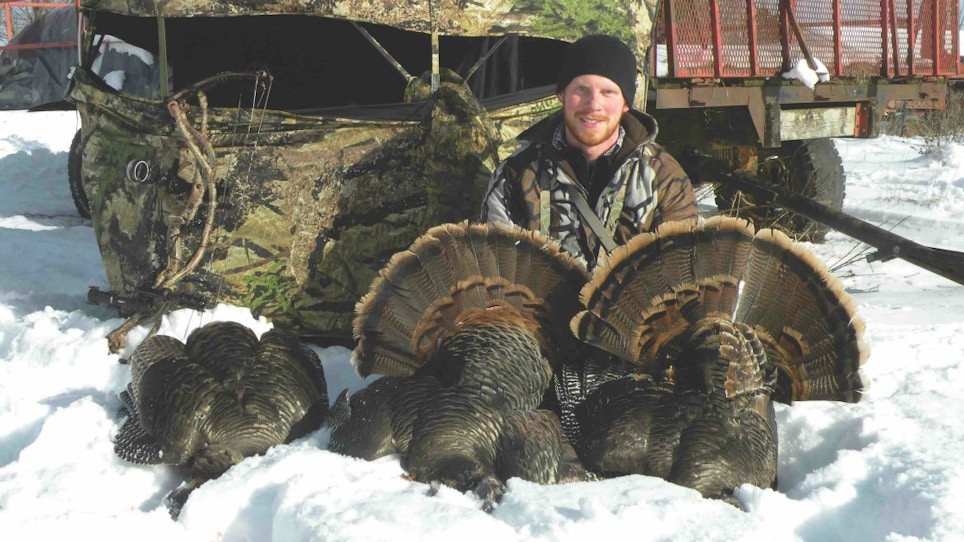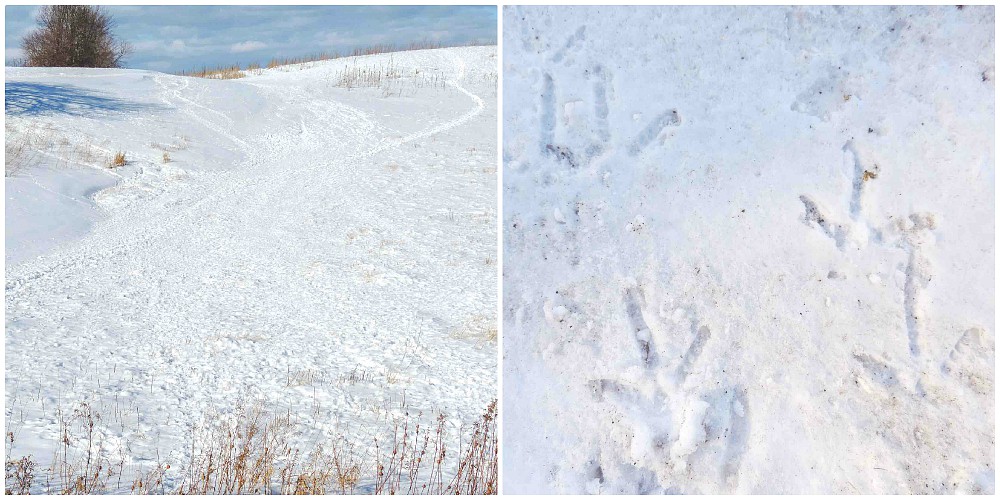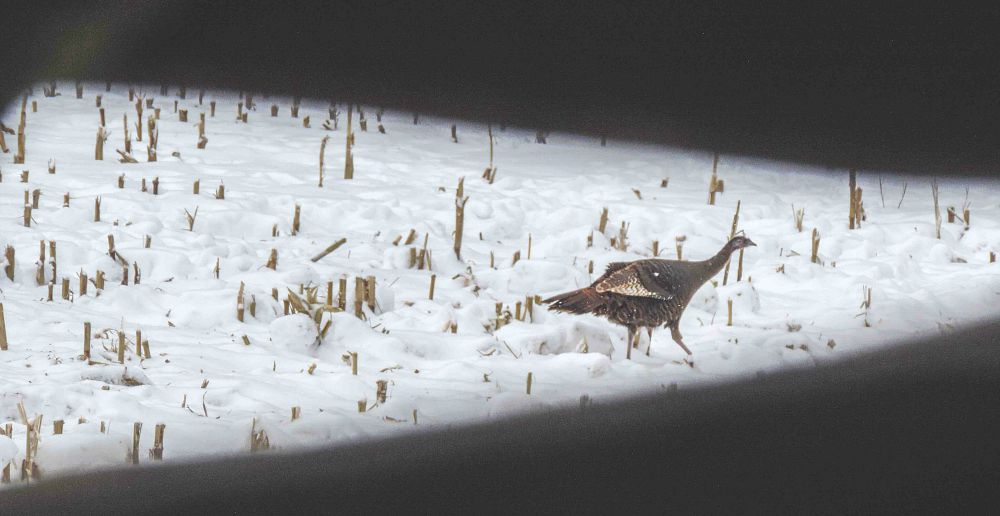As he loads turkey gear into the vehicle, ice crystals form inside his nostrils with each inhalation. He starts the vehicle, then scrapes snow and ice from the windshield before hopping in and shifting into drive. The turkeys will be flying down from their roosts about 90 minutes from now. Time to go. What kind of nut is hunting Wisconsin turkeys on this subzero December morning? Me!
Shortly after filling my thermos with hot coffee at a local convenience store, I reach my hunting location. The farmer explained last night over the telephone what the birds are doing and approximately how many he’s seeing. I’m cautiously optimistic about his 100-plus-bird claim. I must see it for myself. I grab my gear, then trudge through fresh snow to the field behind the barn.
Not far into the field, I crouch down and see snowed-in turkey tracks galore. I push ahead 15 yards beyond the “turkey highway,” then carefully pop open my blind and crawl in, assuming the birds, based on the farmer’s report, are roosting in the jungle-thick hemlock swamp on the field edge some 100 yards away. I stave off the cold with gulps of hot coffee as I await the morning’s events.
Dawn is still a half-hour away, but tree talk soon confirms that dozens of birds are roosted to the south. Suddenly, they sail from the trees in swarms. I don’t attempt to count them; instead, I agree with the farmer that there are 100 or more. I’m a kid in a candy store. I haven’t witnessed a sight quite like this while fall turkey hunting, well, ever.
A pod of birds marches my way, and I quickly pick out a tom as the first victim. At 100 yards and closing fast, the gobbler will be within bow range in seconds. My heart throbs wildly inside my chest, and plumes of breath billow from the blind. It’s go-time. I lift my rangefinder to confirm the distance to the bearded bird: 22 yards. My Hoyt delivers an arrow that throttles the gobbler, and he runs a short distance before slumping in a motionless heap.
My silent weapon hasn’t alarmed other birds, plus dozens more are traveling my way. This is good; I have another turkey tag in my pocket. I peer out the back of my blind and spot several birds feeding in the cornfield. I choose a mature hen and range her at 30 yards. I reach full draw, but I’m not steady — perhaps the fever from the gobbler hasn’t yet subsided — so I let down. Seconds pass, and I draw again. This time, my arrow launches and thumps the bird perfectly. Death immediately follows. Thank God; my turkey tags are full before the wintery bite has a chance to attack my core.
A Target-Rich Environment
The aspect I love most about bowhunting turkeys in the snow is the sheer number of birds you can encounter. Birds habitually “flock up” when snow deepens and temperatures plummet. This hunt presents both chills and thrills, and after a difficult November of deer hunting — watching the wind and staying scent-free with sometimes little or no rewards — I welcome this hunt because I know I’ll get my chance to bloody an arrow — or three.
Perhaps you haven’t bowhunted turkeys in the snow because you’ve been so focused on deer that you haven’t had the time or desire to try it. If you have an unpunched deer tag, I’m all for committing to that, but if conditions aren’t ideal, or you just need a change in pace from the deer-hunting grind, winter turkeys provide the chance to keep your mind and shooting skills sharp. Plus, I absolutely love wild poultry.
If I’ve piqued your interest, let me walk you through some tips that help me topple a heap of turkeys during snowy December conditions each year.
Simple Scouting
Like any type of hunting, location is everything when hunting winter turkeys. If you hunt where big flocks winter, you can experience a stellar hunt. If not, you can freeze your bum off and have little or no fun at all. But don’t fret, because scouting winter turkeys and finding a solid ambush location is incredibly straightforward.
I drive around near farms with cornfields lined with roosting trees — usually a thick swamp that provides shelter against snow and wind. If birds are there, you’ll likely see them out and about virtually any time of day, but especially during mornings and late afternoons as they come and go from the roost. That’s literally the extent of my scouting, because I know that when I go to hunt, I’ll see turkey tracks, scratch marks and droppings littering the snow. Then, I set up nearby.
One note about having solid backup spots: Turkeys typically inhabit the same farms each winter here in Wisconsin, but flock size certainly varies based on crop rotation and food availability. For example, last December when I called the farmer who traditionally has a 100-bird flock on his farm, he shared that he had only 20 birds. Of course, that’s still enough to make a fun hunt, but a tip from my father who works in real estate yielded a higher-odds opportunity where a potential 200 birds were wintering. I collected two turkeys from that backup farm and was covered up in birds.
Deploy a Deadly Setup
When hunting gobblers in the spring, I prefer to leave my blind at home and stay mobile — an approach that yields more gobblers in fewer hours of hunting. Not so in the fall/winter. When hunting huge flocks, I know I’ll have a gazillion eyes to contend with when I move and draw my bow. So, I always hunt from my Primos Double Bull Blind. Its black-out interior hides virtually all of my movements and allows me to bring along additional gear to keep me warm.
As I mentioned under the previous subhead, my strategy is literally as simple as finding the highest concentration of turkey tracks, droppings and scratch marks, then placing my blind 15 yards away from that point. At some point during the hunt, birds should walk by.
Chances are you already know this, but turkeys pay blinds placed in the wide open little to no attention. However, this can change if you let turkeys see you get in and out of it a few times, or if you shoot a turkey or two from it. When they shy away from a blind that’s been overhunted, try to find an equally good setup, but where you can back the blind against a hay bale or farm equipment.
Mornings Over Evenings
When hunting large flocks of birds that are spending nearly their entire day in farm fields and around cattle lots, approaching and setting up a blind in the afternoon presents a dilemma. However, there are two ways to make it happen. Turkeys around farms are accustomed to vehicles and machinery driving around, so it’s wise to have someone drive you out to a setup location, wait for you to pop up your blind and get in, then drive away. The second option is to walk around in full view of the birds without being sneaky. Just act like you’re going about chores. The birds might move off initially, but will likely be back if you’re hunting where they must feed to survive the deep snow and cold weather.
Still, I prefer the morning hunt, not counting waking early and trading a nice warm bed for a cold blind. I love watching birds come off the roost, plus I can get set up undetected in the pre-dawn darkness. If possible, I prefer to hunt unsuspecting birds, and a morning maneuver affords that option.
Now, snow can be crusty and noisy in the mornings, so I don’t set up underneath roosting areas. Instead, I hunt a couple hundred yards away at the first location birds feed once they fly down. The commotion of walking in and setting up has little effect from this distance, provided you go slow and remain as quiet as possible.
This ambush lets me watch birds approach, giving me plenty of time to choose mature birds, then range them as they approach shooting range. Don’t overthink it — If you set up near a track-peppered trail that creates a swath through the deep snow, in time, you’ll get your chances. Honestly, it’s not much different than hunting late-season whitetails. You hunt between their sleeping and feeding quarters, but with turkeys, shot opportunities are more abundant due to the sheer number of legal animals roaming erratically about.
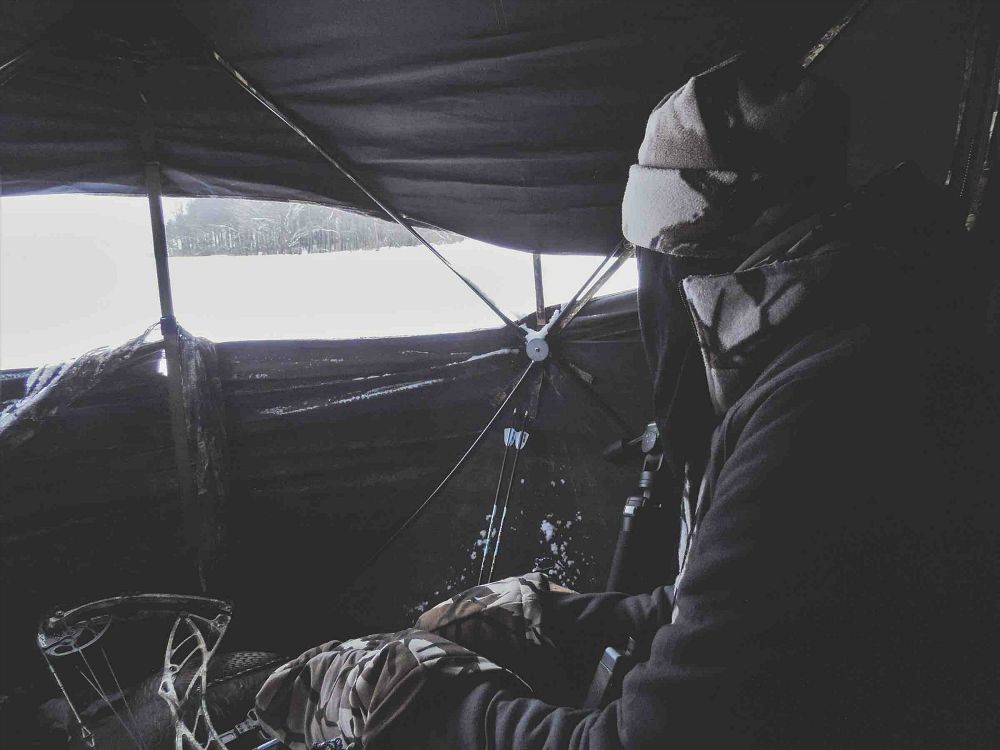
A ground blind is a must for the snowy-day turkey hunter. Not only will a blind help with warmth, but it also conceals you from all those beady little eyes.
Extra Details
Once set up, I try to push snow to the edges of my blind or even outside of it. This does two things. First, it lets me shift my feet or knees (when kneeling) without making noise, plus the wall it creates around my blind muffles noise and reduces the wind chill inside the blind.
I think people often misconceive that hens and poults are easily anchored. With perfect arrow placement, they are. However, they are very little targets, and if you’re even slightly off the mark, they may go airborne, never to be seen again. I’ve hit multiple hens over the years that required follow-up shots even though they were hit with large mechanical broadheads. Without the big cutting diameter, I’m not even sure I would’ve recovered them. Consequently, I suggest that you shoot large, mechanical broadheads, aim small and take only close shots you know you can ace. One arduous recovery that requires stomping around the entire farm could quickly turn your hotspot sour, and that’s a bad deal if you or your family/buddies have more turkey tags to fill.
Back to the Blind
During conditions similar to those referenced in the opening success anecdote, my then-fiancée, Rebecca — now my wife of more than 4 years — and I took a morning mission to the same farm. Birds were galore, just like a few years earlier. Three turkey tags burned holes through my pocket, and I put my Hoyt Carbon Matrix RKT to work shortly after sunup. When the snow and feathers settled, I had three mature hens to show for our efforts, one sporting a 7-inch beard. Several days later on Christmas Eve, those hens became tasty turkey tenders at my family’s annual feast.
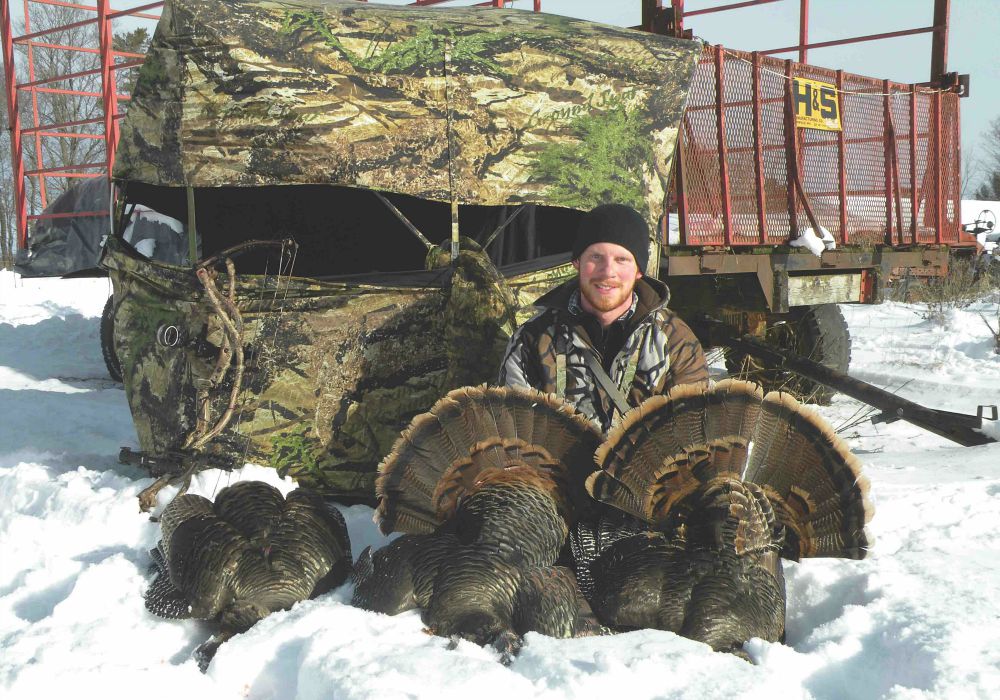
The author is all smiles after his winter poultryapalooza. The right ground blind set in the right locale could create the same photo op for you.
Enduring subzero conditions with the goal of taking turkeys may not have the same level of excitement as chasing a big whitetail, but it’s a riot all its own. Milder conditions are obviously more bowhunter-friendly, but waiting for snow and frigid temperatures ensures that birds will be flocked up in large numbers where shot opportunities abound. The chills and thrills are addicting, and if your deer tags are full, or you just need a change in pace from the deer-hunting grind, give snowbirds a try. I believe you’ll enjoy it.
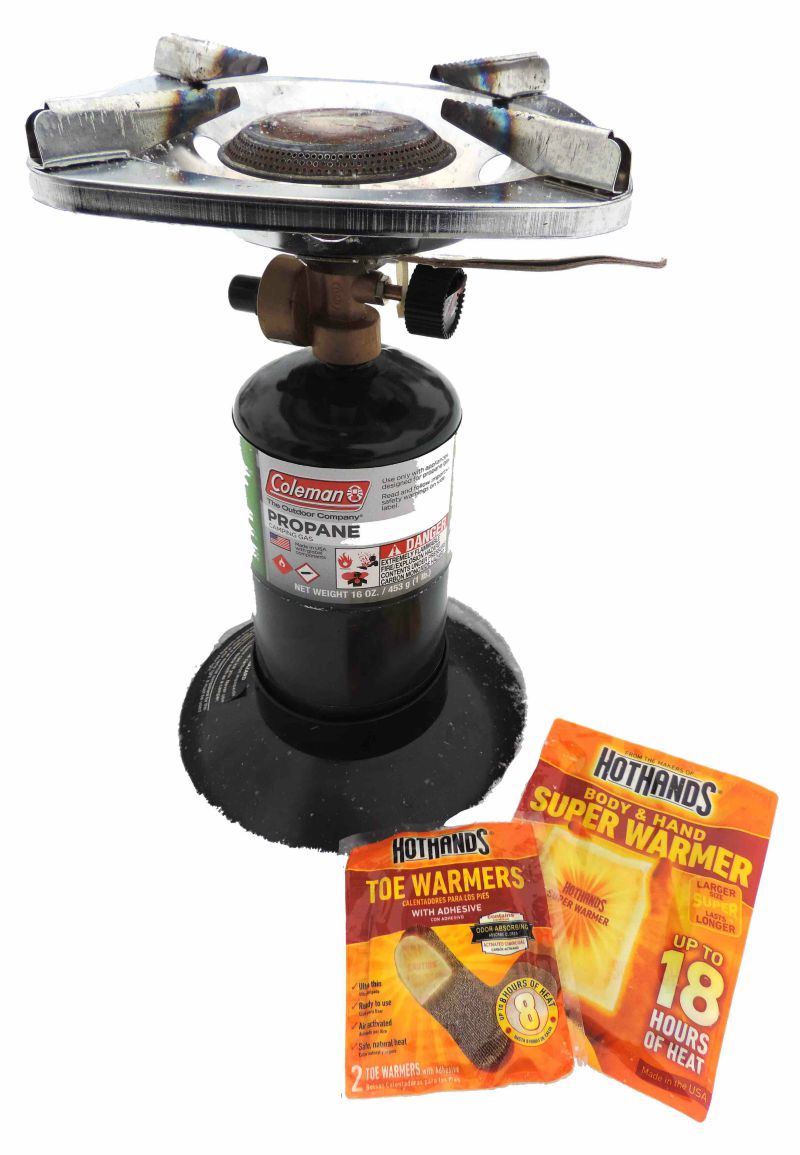 Sidebar: Beating the Brutal Cold
Sidebar: Beating the Brutal Cold
Sitting in a blind for several hours on snow can chill you to the core. Let me suggest several things to help buck the cold.
First, use your ground blind bag as a foot mat. Placing your boot outsoles on the fabric rather than directly on snow will reduce the heat-sapping effects.
Second, load up with chemical hand, foot and body warmers. I wear only thin gloves so I can shoot unencumbered with my release, so hand warmers keep my fingers warm and working.
Next, I often carry a small propane heater to help heat the blind. If you plan to hunt very long, this tool is a Godsend. Just make sure that you carry a lighter if your heater/stove isn’t equipped with an ignitor switch. Even if it is, it’s still wise to carry a lighter in case the ignitor fails. One propane cylinder lasts a few hours on low heat, so depending on the heat intensity you desire and the duration of your hunt, consider carrying two cylinders. Be sure to properly ventilate your blind so you don’t become subject to the fumes.
Finally, in extreme cold, your body rapidly burns calories as it fights to stay warm. Pack a thermos filled with a hot drink and several high-carb snacks. These will fuel your internal furnace so that you can hunt longer.
